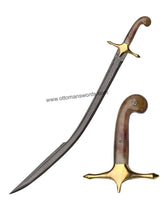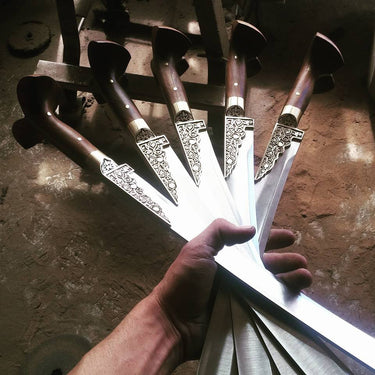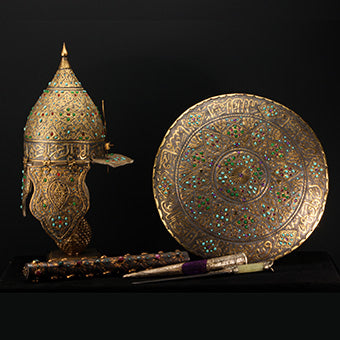What was the secret of Fatih Sultan Mehmet's sword?
The place and importance of the sword, which has been a war tool throughout history, in Turkish art is not different from other works of art. The Ottomans are at the forefront among those who respect the sword the most. Ottoman sultans, who were skilled in warfare, gained fame with their skillful use of swords. So much so that one of the most important works exhibited in Topkapı Palace is the sword of Fatih Sultan Mehmed. The sword that Fatih had made after conquering Istanbul to use in ceremonies is 2 kilos and 125 centimeters. There is also a prayer written on the sword made of steel, solid, iron and gold to give power and strength to the sultan.
The meaning of the writings and verses written on the sword is as follows: Bismillahirrahmanirrahim. "Praise be to Almighty Allah, who strengthens the ties of the true religion with shimmering and clear-letter verses and sharp and bright swords. Salat and blessings be upon Prophet Muhammad and his family, who were described with the most beautiful and correct words. O Allah! Give strength to Mehmed Han, son of Sultan Murad Han, the sultan of veterans and mujahideen, the sharp sword drawn for jihad, and make the scabbard of his sword on the neck of the enemies of the law, and the ink of his pen under the grace of the Lord of the worlds. He is Orhan Han, son of Sultan Osman Han. Mehmed Khan, the son of Murat Han, son of Murat Han, son of Bayezid Han. May God irrigate the soil of their graves with pure water flowing from the swords of the veterans, and make the paradise under the shadow of the swords their place! Amen Ya Rabbel of the world."
THE TRADITION OF KUTBE WITH THE SWORD
The decision of the Conquest of Istanbul was taken at the Ulu Mosque. After Sultan Mehmet Han took this decision in Edirne, he led the Friday prayer here. He reads the sermon with the sword, says 'Bismillah' from here, sets out, and the Conquest of Istanbul becomes Müyesser. In the period when he was the capital of the Ottoman Empire for 92 years, the enthronement ceremonies and sword-wielding ceremonies of the princes were also held in the Ulu Mosque.
ORIGIN OF THE WORD SWORD
In all Turkish dialects, the word is almost always seen as sword, rarely in the form of sword and kilic, kilis, kilish. In Arabic, the word "seyf", which usually means "to destroy", is used in Persian, and the word "Şemşîr" in Ottoman is used in addition to -sword.
The sword, which has been regarded as the representative of heroism, independence and power since ancient times, was generally carried by nobles, high-ranking soldiers and commanders in both the East and the West. Swords are divided into straight and curved. Of these, two of the straights and one side of the curves are sharp. The curved swords, which are shorter than the others and the inside of the curve is sharp, are called machetes.
The sword consists of the handle, which is called the hilt because it has the place to be held, and the cutting part called the barrel (base) because the name of the master or owner is engraved on it. The shield that provides a comfortable grip between the handle and the barrel and prevents the hand from slipping during the shot is called a balçak; In some swords, the part of the slime that bends backwards like a bridge and protects the hand from the blows in the sword-to-sword collisions is called the calf arch or hilt shield. In curved swords, there is a double-edged sharp part called yalman (zübâb in Arabic) near the junction of the ridge of the muzzle and the sharp blade, so that the weapon can be stabbed. The barrel is kept on wood, usually in a leather-covered sheath (scabbard), and the sword is carried by hanging it on the waist or shoulder with a strap.
Two of them are Hz. Prophet, one of them Hz. There are about twenty swords attributed to Davud and others to Hulefa-yi Raşidin and his companions. The oldest of the curved swords in our museums belong to the Mamluk period. The length of the sword belonging to Sultan Kalavun, including the hilt, is 91.5 centimeters, among the swords captured with the Ottoman conquest of Egypt and preserved in the Topkapı Palace Museum; The hilt and slime were renovated in the 18th century.
Muhammed b. The inscription and decoration on Kalavun's sword belong to a later period. Among the swords attributed to Sultan Kayitbay, besides the curved ones, there are also straight and armor-piercing crochet hooks. On some Mamluk swords, large inscriptions attract attention, as can be seen in other examples of metalwork. Some of them have arabesque motifs that are compatible with each other on the hilt, balcak and soles.
The swords of Übulle (Iraq), Damascus and Busra, Yemen, Kirman, Kum, Khorasan, Isfahan, Cairo, Tuleytula (Toledo), Işbiliye (Seville) and Granada (Granada) were known in the Islamic world. The most famous swordsmen were from the Turks and Iranians. Chinese sources also mention the skills of Turks in quenching steel.
Ottoman swords are generally curved, double-edged like the first Islamic swords, straight, serpentine, shaft, yatanan and machete. One of the oldest examples of curved swords, called the original Turkish sword, belongs to Fatih Sultan Mehmed. The hilt of the sword is of walrus teeth.
Its thick-backed and slightly curved muzzle has a wide blood groove extending to the tip. On one side of the barrel, gold inlaid curled branches and other herbal decorations, on the other side, a text containing basmala, praise, prayer and salâtu-selâm was written, mentioning Fatih's grandfathers, who went as far as Osman Gazi.
Among the swords belonging to Fatih, the straight, wide barrel with double grooves and a triangular pointed tip has a length of 104.5 centimeters including the hilt. and some hadiths (Shahada) were written.
II. 90 cm of the one belonging to Bayezid. There are four rows of blood grooves on its long barrel and a victory prayer with the name of the sultan near the hilt. The slightly curved hilt and calf of the sword are made of solid iron and decorated with gold inlaid floral motifs.
The decorated swords, which were mostly used in ceremonies and reception days, were given to some masters to be processed by the chief treasurer. The places where swords were made were called Kılıçhane or Dımışkīhâne because of the reputation of Damascus in this regard. From the information given by Evliya Çelebi, it is understood that the sword masters called şemşîrkar made swords in the types called ticânî, magribî, zivziki and tirâzî.
Due to the widespread use of firearms, XVIII. After the 19th century, the Ottomans' manufacture of swords lost its former quality, and over time it began to be used as an accessory of uniforms in ceremonies, and this tradition has continued until today.











